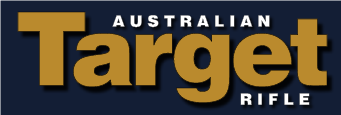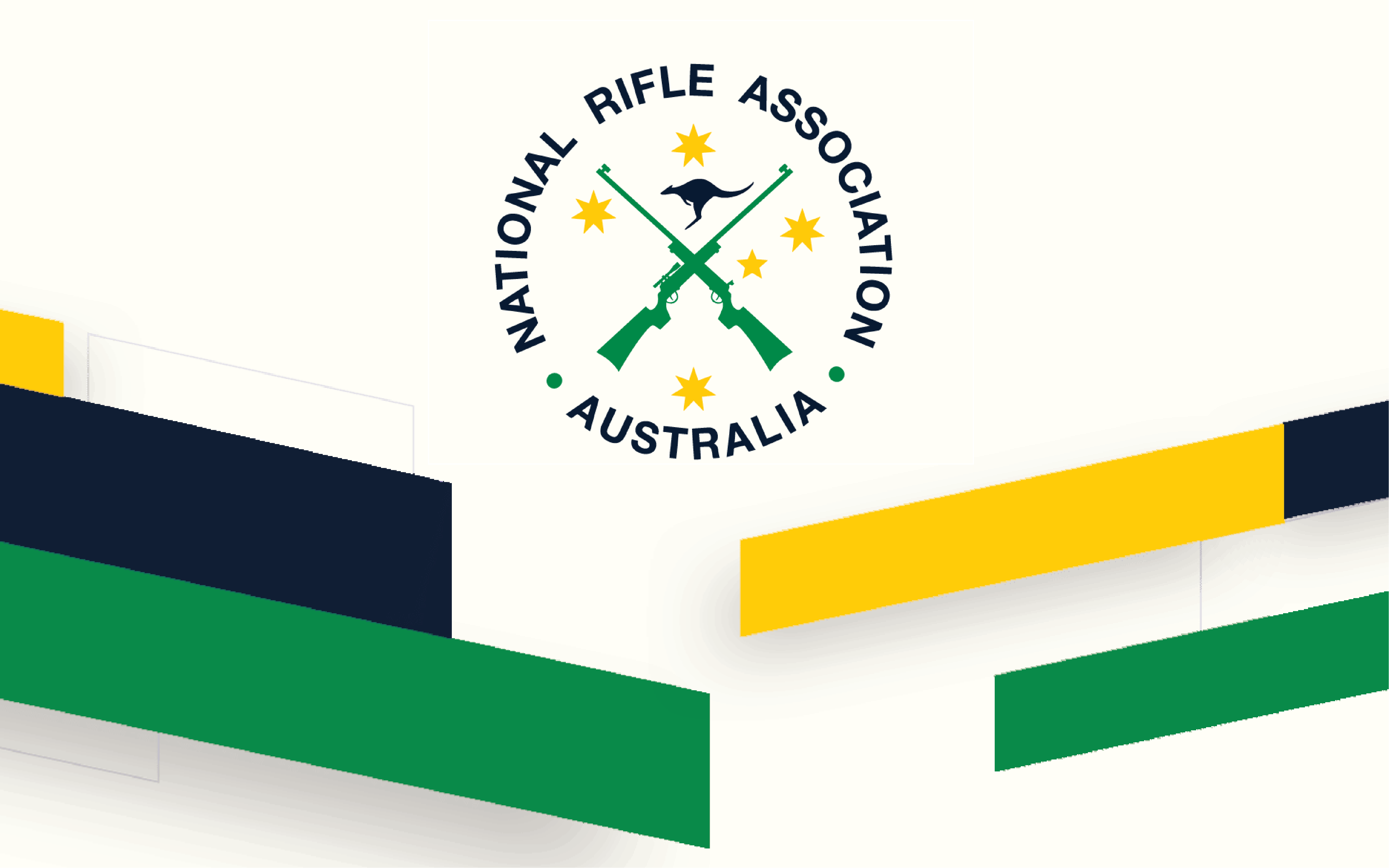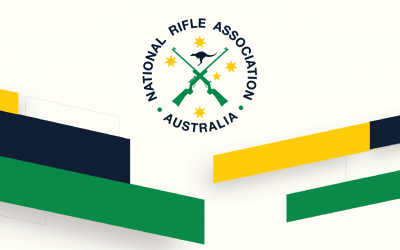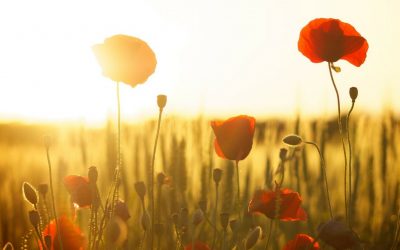Following Federation, attention turned to sending an Australian representative team to international competitions including Bisley. Prior to this, each colonial State might field its own team such as the Victorian Team that won the Kolapore Cup in 1897.
Indeed, the earliest newspaper record we find of any mention of a “Bisley Test” is from the Williamstown Advertiser for 3rd April 1897 for that Victorian team sponsored by David Syme.
The early years of Australian/Federal Team selection were caught up in initial delays and disagreements followed by what became a decades long period where the Australian Teams were selected under a quota system rather than the selection of the “best” performing shots in Australia. The quota was based on State population with proportional funding to be provided. Rifle Club Members who were nominated or invited, typically competed in a series of shoots for a place in a State’s quota. These were referred to as the “Bisley Tests”. It seems too that selection may have been, in some cases, under influence being brought to bear from the Council of each State’s Rifle Association.
The Beginnings – 1900-1910
An invitation from the NRA[1] in England was received in early 1900 but with Federation arrangements settling in and the Boer War in progress, newspaper reports tell us that no “Federal Team” would be sent to Bisley[2] [3]that year and it appears that no Team was sent in 1901 for the same reason – Australia’s involvement in South Africa, with funds/grants being requested from the Federal Government in June[4] of that year for the following year’s competition.
In January 1901 we also find the first mention of a quota system proposed for the makeup of an Australian team.
AUSTRALIAN TEAM FOR BISLEY[5]. (from The Age, 4 Jan 1901)
Owing to the Anglo-Boer war, no Australian team was sent to England to compete at the National Rifle Association matches at Bisley last year; but the hope is expressed on all sides that Australia will be represented at this year’s matches in England. Not only is this feeling prevalent here, but it exists also in the National Rifle Association itself. The secretary of the association recently sent letter to the secretary of the Federal Rifle Association of Australia[6] (Lieutenant-Colonel Davies. of Tasmania), expressing a hope that an Australian team would be sent to Bisley in July next, to contest the Kolapore Cup of 1901 and other events. The letter has been duly acknowledged, with the intimation that all practical means will be employed to secure a realisation of the hope.
At a meeting of the Federal Council last year, the terms of the representation of each State concerned in an Australian team were agreed upon as follow:— New South Wales, four men; Victoria, four; Queensland, four; South Australia, two; and Tasmania, one, making fifteen in all, from whom any competing team in England, Canada, America or elsewhere would be picked.
At a meeting of the Federal Council held in Hobart recently, at which Colonel Robertson attended as delegate for Victoria, it was decided to make early application to the Federal Government for a money grant in aid of the object of Australian representation at Bisley, &c. the amount to be asked tor is £2000.
It was initially suggested[7] by Mr Melville, Minister for Defence that States pay an amount proportional to their population towards the cost of sending a team to Bisley. While some States agreed to this, NSW raised the point that if proportional payments were being made then the membership of the team should be in the same proportion or else to pay support proportional to the number[8] of each State’s team membership as selected.
In early 1902 the matter of sending a Team to Bisley was raised again but not without further controversy.
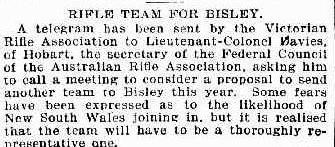
There is, however, a difficulty which threatens to be serious[10]. The New South Wales association have been asking for representation on the Federal council on a proper basis, instead of allowing each State to be represented by two delegates, as provided in the Federal Defences Bill. Unless the Bill becomes law this session the team will in all probability not go to England. Another difficulty which presents itself is in regard to funds, and the Federal Government will be asked to provide the money required. It is hoped that all the obstacles in the way will be removed, and that a strong team, worthy to uphold the reputation of Australia will be selected.
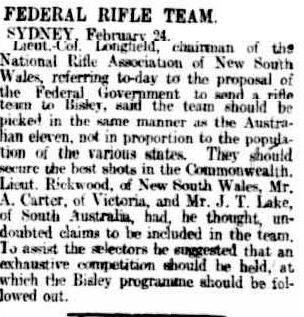
In February the Secretary to the Minister of Defence wrote to the Hon. Secretary of the Commonwealth Council of the Rifle Associations of Australia[11] saying that the Commonwealth Government had approved £2000 for a team on condition that the team consisted of 8 members and 3 waiting members under the command of an officer, all of whom to belong to the Defence Force.
General Hutton who was the Federal Commander wished to be included in a meeting to decide on the method to select the team.
Left: Adelaide Register 25 Feb 1902
Later in the same month it was reported[12] that;
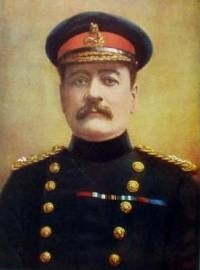
The popular opinion favours a team of 12 men chosen as follows Victoria New South Wales 4, Queensland 2, South Australia 2. That with an energetic manager, would compose a team which would be thoroughly representative and could be relied upon to give a good account of itself.
The selection process was decided by the Commonwealth Council of the Australian Rifle Association[13] to be that each State was to hold 4 competitions and select men as were considered fit to occupy places in the team, and that a sub-committee be appointed by the council, consisting of one delegate from each state to make the final selection from the names submitted. Left. General Edward Hutton[14]
By the end of March 1902[15] NSW had held its competitions for positions and announced:
It was unanimously resolved that Mr G Lindsay, Lieutenant W G Rickwood, Mr J. J. Mathison, W O Ingall, and Lieutenant J O Miller be nominated for thy Bisley team, they being the five highest scorers in the practices Mr R Lennox-, Lieutenant Colonel Oldershaw, and Mr A H Jacobs were, on a ballot, elected by clear majority as the remaining nominees of the association.
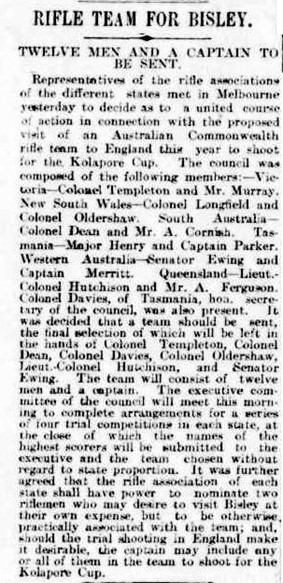
In April, the team had been selected however the Government’s support[16] for funds was withdrawn and the cost of sending the team was opened to public subscription. The team was in the end selected in proportion to the amount of funding raised by each state.
The NSW Association appeared to be somewhat put out by the selection process, the expectations for funds and perhaps Victoria’s[17] ability to dominate the whole process by raising the lion’s share of the money and so able to send the most number of team members, caused the NSW riflemen put forward for the team and the funds raised to be withdrawn.
Left: The Argus 6 March 1902[18]
THE BISLEY TEAM[19]
After many trials and tribulations on the part of the organisers the team of rifle shots for Bisley have sailed for London by the R.M.S Rome. There are no New South Wales representatives in the team, nor will the originally-selected Queenslanders participate in the venture. The northern State will, however, send Mr Alex. Ferguson, who goes at his own. expense, and Mr Geo. Shaw. Mr J. T. Lake (South Australia), is to join the Rome-at Adelaide. With the withdrawal of New South Wales from the team Victoria will now have six representatives, the latest being Corporal Williams, who has been called upon to fill one of the vacancies. It seems likely therefore that with the presence in England of Mr J. Sloane and Mr J. Grummet, who have already gone ahead, the team of eight to shoot for the Kolapore Cup will be entirely Victorian, unless Mr J. T. Lake, of South Australia, is picked. Mr David Syme, proprietor of the Age, has subscribed £100 towards the local fund, and a similar amount has been given by Messrs Wilson. and McKinon proprietors of the Argus.
After all the politics and machinations, the 1902 Australian Team won the Kolapore.[20]
This team selection process set the scene for the following decades with little change however the process continued to be questioned by various State associations. We see in 1905 one variation[21] where each State was to hold simultaneous competitions and nominate 5 men for final selection, it is assumed by the Commonwealth Council of Rifle Associations. Another was the expectations that individuals who paid their own way might be seconded into any Australian team.
Further questioning of the quota system is noted in 1907 where the idea of the “best” team was again raised.
From the Examiner 5 Jan 1907
SELECTING FOR BISLEY.
The decision of the Commonwealth Council to send an Australian team to Bisley has been received with great satisfaction in rifle shooting circles at Sydney, but again the question has cropped up as to whether the representation of any state should be limited to a fixed proportion of the full establishment, in as much as, because of the state limit, it is always possible that the efficient representation of the Commonwealth as a whole may be impaired. it is quite possible (says a Sydney paper) that while New South Wales and Victoria are each restricted to three representatives and the other states to a proportionate number, there might be found in any one of the states one, or even more, riflemen who would excel in general proficiency for team purposes, but, who, in the immediate selection of the state representatives, might possibly fall a point or so short of the man or men included in the number allowed. Should such a contingency happen, and it is by no means admitted that such has not, happened in the past, Australia would, under this method of selection, be inadequately before the public in the international competitors at Bisley. In other words, we run the risk of the representative team not being such in fact, but an aggregation of members selected upon the basis of state interests, as distinct from ‘the greater issue of Commonwealth representation. The distinction, to an outsider, may be difficult to define in words, but riflemen who have had experience in the selection of national teams quite appreciate the meaning of the comment. It is difficult to see upon what basis the national representative team could be selected other than by the adoption of the pro rata principle, but thoughtful followers of rifle-shooting and keen advocates of the participation in the Bisley contests– men who have no direct interest as possible competitors agree generally that there is a good opportunity for the representative association delegates to devise some plan that would preclude the risk of Australia’s defeat by reason of technicalities interfering with the selection of Australia’s absolutely best team.
A quota system was even considered during the selection of the post WW1 Diggers Team of 1919.
Moving on through the decades the quota system carried on as did the questions about it being a true representation of Australia’s best shooters.
Other perceived influences on selection to be suggested through the years were Freemasonry as well as bias from selection committees. There is however no actual evidence of this.
The major reference for this article has been NLA Trove newspapers. The most recent article that can be found that confirms the continuation of the quota system is from 1981 where Ron Negus was selected as one of NSW’s quota of 3.
One of the first indications of the end of the quota system was at the 1988 Palma Match held in Australia. Tony Moon and Neil Gibbins both recall that Alistair McPherson wanted to ensure that Australia was best represented on home soil with the intention of ensuring a Palma win. McPherson added 9 names to the selected quota of whom 8 made the Australian Palma Team on performance.
Later, in 1996, we know that Graeme Berman Captained a team to Bisley where he had picked his own team in order to be in the best position to win both the Kolapore and the McKinnon. They won the McKinnon with a score 15 points over the previous record.
Australian Team selection has now moved on from the quota system. A Captain is appointed and it is a process of self-nomination of both shooters and coaches with the final selections taken from the squad based on proven performance.
The origins of the quota system for selecting an Australian Shooting Team may have been based on the feelings at the period of Federation and trying to ensure that the ‘whole” of a new Australia was represented. How this system prevailed for 80 or more years is difficult to understand. In hindsight, it could be considered that a performance based team selection would have realised more successes.
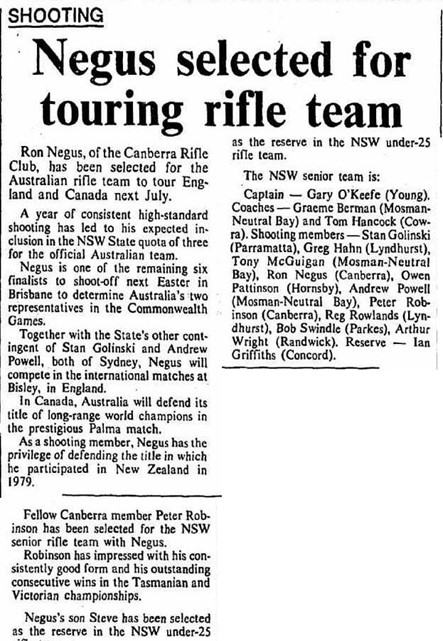
With Thanks to:
Neil Gibbins, Rick Ashton & Tony Moon
Articles of Interest for Further Reading:
1903
https://trove.nla.gov.au/newspaper/article/181798773?searchTerm=bisley%2C%20team
https://trove.nla.gov.au/newspaper/article/12259956?searchTerm=bisley%2C%20team
https://trove.nla.gov.au/newspaper/article/208947322?searchTerm=bisley%2C%20team
https://trove.nla.gov.au/newspaper/article/14521585?searchTerm=bisley%2C%20team
https://trove.nla.gov.au/newspaper/article/24858047?searchTerm=australian%20rifle%20tem%2C%20bisley
https://trove.nla.gov.au/newspaper/article/71944475?searchTerm=australian%20rifle%20tem%2C%20bisley
https://trove.nla.gov.au/newspaper/article/153899162?searchTerm=bisley%2C%20team
https://trove.nla.gov.au/newspaper/article/197897112?searchTerm=bisley%2C%20team
https://trove.nla.gov.au/newspaper/article/197907725?searchTerm=bisley%2C%20team
https://trove.nla.gov.au/newspaper/article/14533366?searchTerm=bisley%2C%20team
https://trove.nla.gov.au/newspaper/article/237400839?searchTerm=bisley%2C%20team
https://trove.nla.gov.au/newspaper/article/12271043?searchTerm=bisley%2C%20team
https://trove.nla.gov.au/newspaper/article/197215247?searchTerm=bisley%2C%20team
https://trove.nla.gov.au/newspaper/article/246097172?searchTerm=bisley%2C%20team
https://trove.nla.gov.au/newspaper/article/88854609?searchTerm=bisley%2C%20team
1905
https://trove.nla.gov.au/newspaper/article/28238885?searchTerm=australian%20rifle%20tem%2C%20bisley
1906
https://trove.nla.gov.au/newspaper/article/44504025?searchTerm=bisley%20team
1907
https://trove.nla.gov.au/newspaper/article/45795459?searchTerm=bisley%20team
https://trove.nla.gov.au/newspaper/article/33086761?searchTerm=bisley%20test%2C%20rifle
https://trove.nla.gov.au/newspaper/article/165388092?searchTerm=rifle%2C%20%22Bisley%20test%22
https://trove.nla.gov.au/newspaper/article/157230755?searchTerm=rifle%2C%20%22Bisley%20test%22
1910
https://trove.nla.gov.au/newspaper/article/196486208?searchTerm=bisley%20team
https://trove.nla.gov.au/newspaper/article/15080621?searchTerm=bisley%20team
https://trove.nla.gov.au/newspaper/article/242094789?searchTerm=bisley%20team
1913
https://trove.nla.gov.au/newspaper/article/227868223?searchTerm=bisley%20team
1923
https://trove.nla.gov.au/newspaper/article/1997175?searchTerm=bisley%20test%2C%20rifle%20shooting
1928
https://trove.nla.gov.au/newspaper/article/129161465?searchTerm=bisley%20test%2C%20rifle
1937
https://trove.nla.gov.au/newspaper/article/127620332?searchTerm=bisley%20rifle%20team%2C%20forbes
https://trove.nla.gov.au/newspaper/article/266790145?searchTerm=bisley%20rifle%20team%2C%20forbes
1948
https://trove.nla.gov.au/newspaper/article/69071346?searchTerm=bisley%20rifle%20team
https://trove.nla.gov.au/newspaper/article/49641165?searchTerm=bisley%20rifle%20team
Endnotes:
[1] https://trove.nla.gov.au/newspaper/article/9044588?searchTerm=rifle%20team%2C%20bisley
[2] https://trove.nla.gov.au/newspaper/article/64496613?searchTerm=rifle%20team%2C%20bisley
[3] https://trove.nla.gov.au/newspaper/article/183920762?searchTerm=rifle%20team%2C%20bisley
[4] https://trove.nla.gov.au/newspaper/article/56080519?searchTerm=bisley%2C%20rifle%2C%20team
[5] https://trove.nla.gov.au/newspaper/article/196055618?searchTerm=Australian%20rifle%20team%2C%20bisley
[6] The Federal Rifle Association of Australia appears to be an association of the various Colonial Militia Rifle Associations involved in organising Inter-colonial Matches prior to 1900. Mention in newspaper articles on the NLA Trove website begin in the 1880’s.
A note on its formation may be found in the obituary of Brigadier General George Dean.
[7] https://trove.nla.gov.au/newspaper/article/9044896?searchTerm=rifle%20team%2C%20bisley
[8] https://trove.nla.gov.au/newspaper/article/196020983?searchTerm=rifle%20team%2C%20bisley
[9] https://trove.nla.gov.au/newspaper/article/237333502?searchTerm=rifle%20team%2C%20bisley
[10] https://trove.nla.gov.au/newspaper/article/209139284?searchTerm=rifle%20team%2C%20bisley#
[11] https://trove.nla.gov.au/newspaper/article/9579137?searchTerm=rifle%20team%2C%20bisley
[12] https://trove.nla.gov.au/newspaper/article/9629467?searchTerm=rifle%20team%2C%20bisley#
[13] https://trove.nla.gov.au/newspaper/article/173970519?searchTerm=rifle%20team%2C%20bisley
[14] https://www.bwm.org.au/soldiers/Edward_Hutton.php
[15] https://trove.nla.gov.au/newspaper/article/14430969?searchTerm=australian%20rifle%20tem%2C%20bisley#
[16] https://trove.nla.gov.au/newspaper/article/55664983?searchTerm=australian%20rifle%20tem%2C%20bisley
[17] https://trove.nla.gov.au/newspaper/article/183138820?searchTerm=rifle%2C%20%22Bisley%20test%22
[18] https://trove.nla.gov.au/newspaper/article/9630828?searchTerm=rifle%20team%2C%20bisley
[19]https://trove.nla.gov.au/newspaper/article/196771191?searchTerm=australian%20rifle%20tem%2C%20bisley#
[20] https://trove.nla.gov.au/newspaper/article/24750878?searchTerm=australian%20rifle%20tem%2C%20bisley
[21] https://trove.nla.gov.au/newspaper/article/28238885?searchTerm=australian%20rifle%20tem%2C%20bisley
